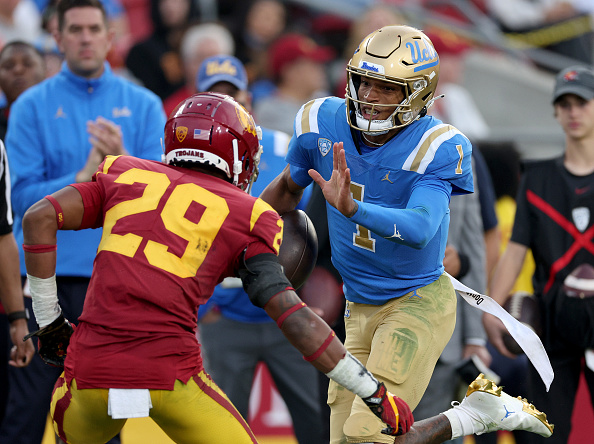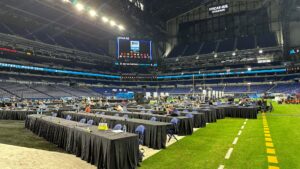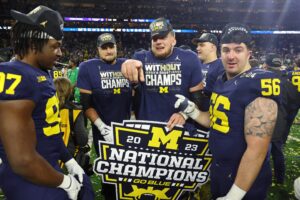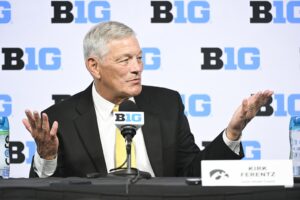Thursday was just another day in the college football landscape. A couple of recruits announced their commitments, some summer camp news, and the two teams in the largest market in the Pac-12 Conference announced their decision to leave for the Big Ten in 2024. One of them, USC, is one of the flagship programs in all of college football. So what is the impact of USC and UCLA moving to the Big Ten on the rest of college football?
Another Seismic Shift: Impact of USC and UCLA Moving Conferences on College Football
It’s no understatement to say that this was yet another seismic shift in the landscape of college football. Los Angeles is easily the biggest market in the Pac-12 and, even with the Lakers and Dodgers, it has the biggest collegiate influence of the four major markets in the Pac-12 (Los Angeles, San Francisco/Oakland, Seattle, and Phoenix). USC, in particular, is one of the bonified blue-bloods in the sport with 11 National Championships, and seven Heisman winners, and is tied with Tennessee at 9th on the all-time collegiate wins list with 856, over 100 more than their nearest West Coast competitor (Washington, 750).
With those stakes, the decision by the L.A. schools to pack up and move to bigger and better pastures carries with it significant impacts on the college game.
The Future of the Pac-12
At least as far as football goes, it’s unlikely that the Pac-12 can survive this move. Without Los Angeles, the market value for television rights drops dramatically. So, too, does the level of competition. Both of those will add up to fewer recruits heading to the remaining schools. And with the L.A. teams moving out, you can expect Oregon and Washington to work the phones like day-before-the-elections political volunteers trying to figure out their options.
It’s not too hard to imagine that the Pac-12, established 107 years ago, won’t make it to its 110th birthday.
The Future of College Football
Once the SEC adds Texas and Oklahoma, both the SEC and the Big 10 will consist of 16 teams, a large majority of those teams capable to contend for conference or national prominence in any given season. With the Big 12 and ACC both currently sitting at 14 schools (plus Notre Dame in the ACC), one can easily imagine a four 16-team structure in college football. The Big 12 could presumably salvage Oregon and Washington and the ACC would permanently add Notre Dame and one other school to round out the “MegaFour” structure.
That would lead to only one thing: the secession of the MegaFour from the NCAA to form their own football league. This league would be a joint business venture between the four conferences rather than an academic confederation of school presidents like the NCAA’s current governance structure. This might be the single biggest impact of USC and UCLA moving to the Big Ten.
The Future of the NCAA
Counter-intuitively, this move to a MegaFour might actually save the NCAA.
Without the unique business strains of Power 5 football, such as NIL legislation, television contracts, potential unionization, constant transfer saga, and divisive playoff expansion discussion, the NCAA can go back to an amateur model to govern the Olympic and other non-revenue sports. With alternative paths to the pros for basketball and baseball, the NCAA can largely ignore the issues that football has saddled them with over the past twenty years.
The one-and-dones and Major League Baseball’s minor league system provide an excuse for the NCAA to continue to implement their amateur model on those revenue-generating sports. USC and UCLA may have just saved the NCAA.
Other Impacts
Obviously, many dominoes will fall as a result of the impact of USC and UCLA moving to the Big Ten.
If MegaFour secession from the NCAA does occur, some schools make use of this secession as an excuse to actually stay in the NCAA. Vanderbilt and Northwestern immediately come to mind, as the big business of MegaFour Football might muddy their primary brand too much for their leadership to handle. You would expect the Big Ten and SEC to help facilitate that soft transition and be ready to replace them with eager replacement, looking for the $100 million payday that will inevitably come from a MegaFour Conference television contract.
NCAA Football will re-align to something that looks very familiar to the old Divsion I, II, and III model. The Group of Five, plus the remaining independents like Army, Liberty and Massachusetts, would constitute Divison I. There would still be high-quality college football at that level. And the lower divisions would remain unchagned as they are today.
And what about the Bowls? If the Pac-12 goes away, the Rose Bowl becomes just another bowl game. This, of course, serves as a marker in the slow deterioration of the essence of the game. The Granddaddy of them All becomes just another naming rights opportunity. Oh, the horror.
And do the remaining Division I teams go to bowls? Or do they have a playoff system like the lower divisions? Can you imagine Appalachian State and Army playing for the Division I national title the week before Christmas?
A Brave New World
No one quite knows what the final impact of USC and UCLA moving conferences will be. But all signs point to another seismic shift in the sport of college football. And this is another step away from the game that has gripped fans for a century.
Change and progress are constants of both time and sport. But sometimes the forces driving change and progress aren’t in the best interest of the sport. At some point, a MegaFour concept will cease to become college athletics and become a semi-professional sport.
The biggest impact of today’s move? Saturdays are beginning to be the only happy days in college football.






